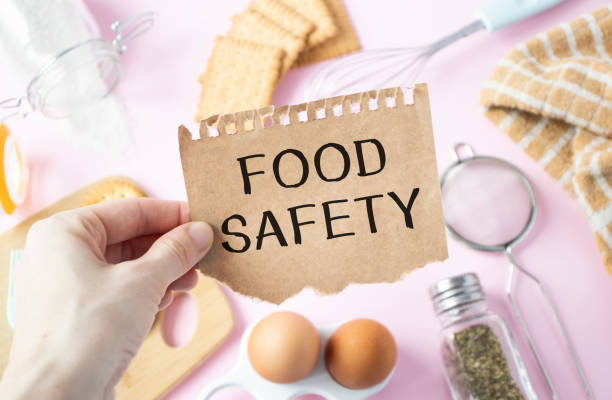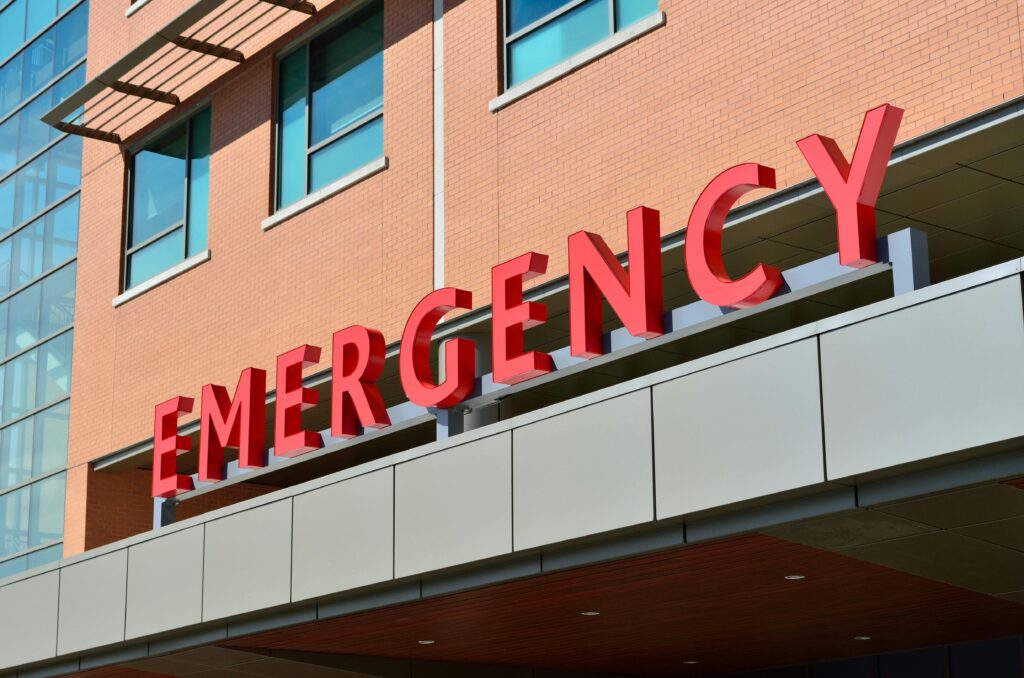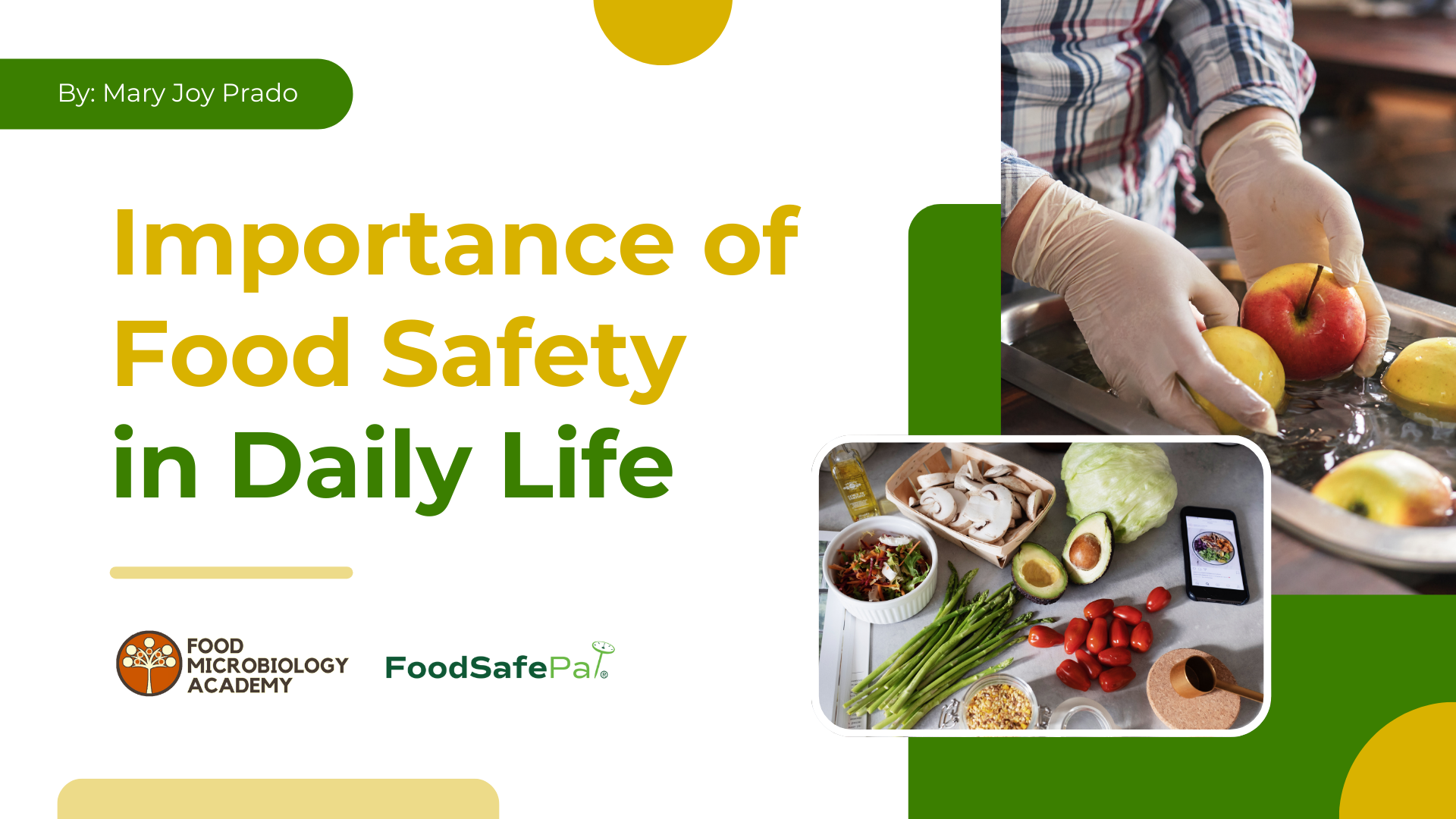A Healthy and Pretty You Starts with Food Safety
Food plays an important role in our everyday lives—not only because it sustains us, but also because it brings comfort, joy, and even cultural identity. Unlike favorite songs or colors that may change over time, our favorite foods remain close to our hearts, whether it’s a refreshing treat on a hot summer day or a warm meal during rainy weather.
For some, eating is simply about survival. For others, it is one of the most enjoyable parts of the day. More often, food is that one thing that can instantly lift someone’s mood—especially after a difficult day. Students might celebrate with ice cream after taking a life-changing Biochemistry exam, while office workers often grab a cup of milk tea to recharge after a long and exhausting schedule.
But beyond satisfaction, food is a basic necessity that directly affects our health and well-being. According to Maslow’s hierarchy of needs, physiological needs are absolutely essential to human functioning and to addressing more complex needs such as relationships, growth, and safety. But how can one truly live a fulfilling life if deprived of these most basic needs—particularly food and the assurance that it is safe to consume?
This is why food safety matters. In this article, we’ll explore what food safety means, why it’s important in daily life, and how it influences not just health—but also beauty, confidence, and overall quality of life.
What’s On Your Plate? Understanding Food Safety

Photo from: https://www.istockphoto.com/photos/food-safety
Food safety is defined as the proper food handling procedures applied during food preparation, processing, storage, and distribution of the products you deal with in your food business. It also means an assurance that the food you prepared, handled, and served will not cause any adverse health effects towards the consumer. It spans the entire farm-to-fork process:
- Production: Following the guidelines based on Good Agricultural Practices and ensuring crops and livestock are free from harmful chemicals or pesticides
- Processing: Following the guidelines based on Current Good Manufacturing Practices and carefully washing with appropriate cleaning agents as well as properly packing
- Distribution: Keeping food at right temperatures and proper conditions to prevent spoilage
- Retail: Preventing contamination while transporting and properly placing on shelves
- Consumer: Proper cooking, hygiene, and sanitation
Here’s an example of a food in a farm-to-fork process perspective.
Food safety is important first and foremost because it protects our health and saves lives. If the food we eat is not safe, we can suffer from foodborne diseases such as Norovirus, Hepatitis A, E.coli, Shigella, and Salmonella. After all, food is meant to be delicious, not dangerous. Yet every year, many people around the world still suffer from foodborne illnesses. In fact, 48 million or 1 in 6 people get sick from a foodborne illness with 128,000 people getting hospitalized. Unfortunately, 3,000 people die from this due to food and drinks being contaminated with germs or chemicals that can make people sick.
For instance, just last July 1 in Olutanga, Zamboanga Sibugay, two individuals died while four others were hospitalized after consuming a deadly puffer fish. The victims showed clear signs of food poisoning. Puffer fish are known to be dangerous because they contain a deadly poison called tetrodotoxin (TTX), which is mostly found in their liver, ovaries, and eyes. The said toxin binds to nerve cells, which in turn blocks signals. Therefore, this causes paralysis and often death due to suffocation. That’s why, in Japan, however, pufferfish (fugu) remains a delicacy. The difference? Only chefs who undergo years of specialized training are licensed to prepare it. This shows how food safety regulations can mean the difference between life and death while still respecting culture and cuisine.
Food safety incidents also contribute to food waste. In the United States, major sources of food wastes are the food industry and consumers. Within the food industry, food waste occurs at every farm-to-fork process. When food is found to be contaminated, entire batches are subject to be disposed of, even if only a portion is unsafe. This not only wastes resources such as water, labor, and energy used in production, but it also significantly reduces the supply of available food distributed to the public. In countries where hunger and malnutrition are pressing issues, food waste due to foodborne illnesses adds to the economic burden.
For instance, in the Philippines, smuggled onions from China were tested by the Bureau of Plant Industry’s Plants Products Safety Services Division and the National Plant Quarantine Services Division. It was found positive for heavy metals and Salmonella. According to Agriculture Secretary Francisco P. Tiu Laurel Jr. it is important that the misdeclared agricultural goods must not enter the country to ensure food safety and stop potential spread of plant diseases and pests.
More Than A Meal: Why Food Safety Matters

Photo from: https://www.pexels.com/photo/emergency-signage-263402/
Beyond health, food safety also reduces healthcare costs and strengthens communities. When fewer people get sick from unsafe food, families obviously spend less on medicines and hospital bills. In this way, they can still continue their work and life. At a larger scale, this means that communities are also prevented from sickness. Hence, they benefit from stronger and healthier populations.
Safe food is also essential for ensuring healthy diets. It provides us the nutrients needed for our skin, hair, and overall energy. Aside from this, it can also improve access to markets and further support economic growth. By providing safe food, it also brings closer towards achieving overall food security. Meaning, everyone has reliable access to enough safe and nutritious food to lead a more conscious, healthier, and more active life.
Beyond the risks on public health, food safety incidents also reduce consumer confidence. When people hear about outbreaks of foodborne illness or contaminated products being recalled, they often become hesitant to buy from the same brand, restaurant, or even an entire food category. Over time, the food, the brand, and the establishment may become permanently associated with the illness in the minds of consumers. This kind of reputational damage can take years to repair and often drives people to seek alternatives elsewhere. In the long run, businesses suffer financial losses, farmers and suppliers lose opportunities, and communities experience economic setbacks—all because trust was broken by a single lapse in food safety.
Ensuring safety at every stage of the farm-to-fork process helps in understanding the interconnectedness of the food system. From the farmer planting seeds, to the distributor transporting goods, to the consumer preparing meals at home, each stage is linked and depends on the other. A single overlook or mistake in one step—such as improper storage, cross-contamination, or inadequate cooking—can compromise the safety of the entire chain. There is a need to recognize the interconnected process to remind us that food safety is not just an individual responsibility but also a shared commitment across producers, businesses, regulators, and consumers.
Food Fighters, Health Heroes: What Can We Do Then?

Photo from: https://www.pexels.com/photo/pile-of-folders-357514/
According to the Food and Agricultural Organization (FAO) Director-General QU Dongyu, food security and food safety are basic rights of human beings. Meaning, individuals must not be deprived of not just food, but safe and adequate food. During the 2020 World Food Safety Day, achieving food security and providing healthy food are one of the global goals as stated in the United Nations (UN) 2030 Agenda for Sustainable Development.
As individuals, being a Food Fighter goes beyond eating what’s on our plate, cooking food at home, and ordering at restaurants. It is also being able to make mindful and conscious food choices that are safe and healthy. This means supporting local farmers, choosing trusted suppliers, and practicing awareness. Moreover, it also means educating yourselves with the concept of food safety and other notable issues surrounding it. To help you get started, a free and downloadable Kitchen Food Safety Checklist is here. This is a simple yet powerful tool to help you maintain a clean, safe, and organized kitchen.
👉 Download your copy and take the first step toward smarter, safer food habits.
For healthcare professionals who are also health guardians, acting as the link between the patients and medical terms, your guidance is important to recognize safe food practices in preventing not just foodborne illnesses, but also chronic diseases related to poor diet. By spreading accurate, science-based information, they empower communities to make healthier decisions. After all, we are meant to serve the public and help these information be digested by them to be used in their daily life.
For business owners, partnerships with governments, public organizations, academia, and the private sector like FoodSafe Pal are needed so that your employers have access to information, tools, and new approaches. Furthermore, this can help in expanding their resources and knowledge as well as maximizing their potential in support of their food safety work. This is in accordance with the fourth strategic outcome set by FAO. By supporting innovation, businesses strengthen their reputation in the long run. Yes, for sustainability!
Lastly, for policymakers, they are both food and health heroes for they have the power to set the tone and agenda for the entire food system. From creating stricter safety regulations to ensuring fair inspections and supporting agricultural sustainability, their decisions shape the foundation of how food is produced, distributed, and consumed. By investing in education, training, and infrastructure, policymakers can create environments where safe food is the standard
At the end of the day, food is what we need and what we want. Safe food means fewer illnesses, stronger communities, and a better quality of life for all. Whether you’re a consumer, a healthcare professional, a business owner, or a policymaker, each of us has a role to play as a Food Fighter and Health Hero.
Start small, stay informed, and share what you learn. For practical tips and trusted resources, check out FoodSafePal, your go-to partner in building safer kitchens and healthier habits. Use the affiliate code foodsafety1 to unlock special tools and guides that help keep every plate safe.
Want to boost your food safety knowledge? Get certified today with FoodSafePal’s Food Handler or Food Manager Training. Use affiliate code foodsafety1 at checkout for savings and unlock special tools and guides that help keep every plate safe.
Because a healthy and pretty you starts with food safety.



